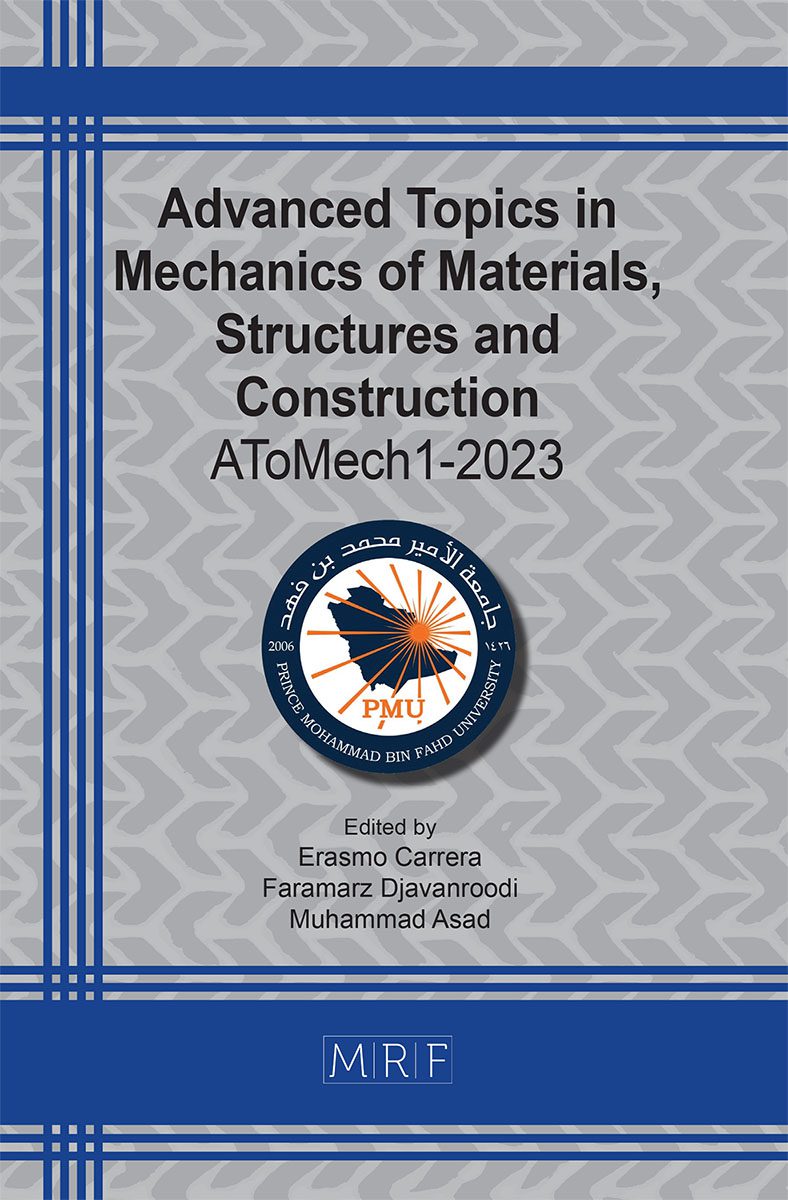Mechanics and failure analysis of stitched sandwich structures damaged by the impact of various energies
Amina Assouli, Bounoua Tab, Fodil Hammadi, Izzeddine Bekkar
download PDFAbstract. In the fields of structural mechanics and failure analysis, the presence of damage to structural materials requires several studies. Expertise, damage, is crucial to understand the behavior of structures under various loading conditions. Generally, this damage affects the most stressed area of the structure and can lead to the accumulation and propagation of damage, leading to the partial or total collapse of the structure. On the other hand, stitched sandwich plates are an innovative structural material with extremely high performance in the fields of building mechanics and others. However, when these plates are damaged, it is essential to study their behavior under subsequent loading conditions to assess their ability to withstand a second impact. After having been damaged by a first impact at low speed, a diagnosis was carried out which showed the capacity of these plates to undergo a new shock. The present work focuses on the study of the behavior of these said plates under the effect of a second impact. First, the plates subject to damage in previous works were subjected to a new constant energy impact in order to observe the cumulative effect. In the second part, repeated impact tests were applied to healthy plates according to two different modes. The diversity of impact modes is based on the cycle (time) factor. An immediate repeated shock whereas for the other mode the specimen only suffers a second shock after a rest of 24 hours. An analysis of the behavior of the sandwich plates under the effect of different shocks (without rebound) was carried out. The results obtained showed once again the effectiveness of these structural materials in the face of the effect of impact compared to traditional sandwiches. The damage seen is characterized by positioning and pivoting around the point of impact and is limited to the edges of the collider’s diameter and depth. Fracture analysis of these plates indicated that the damage resulted in a decrease in their bearing capacity.
Keywords
Mechanical, Failure Analysis, First Impact, Stitched Sandwich, Damage, Shock Accumulation, Shock without Rebound
Published online 8/10/2023, 11 pages
Copyright © 2023 by the author(s)
Published under license by Materials Research Forum LLC., Millersville PA, USA
Citation: Amina Assouli, Bounoua Tab, Fodil Hammadi, Izzeddine Bekkar, Mechanics and failure analysis of stitched sandwich structures damaged by the impact of various energies, Materials Research Proceedings, Vol. 31, pp 704-714, 2023
DOI: https://doi.org/10.21741/9781644902592-72
The article was published as article 72 of the book Advanced Topics in Mechanics of Materials, Structures and Construction
![]() Content from this work may be used under the terms of the Creative Commons Attribution 3.0 license. Any further distribution of this work must maintain attribution to the author(s) and the title of the work, journal citation and DOI.
Content from this work may be used under the terms of the Creative Commons Attribution 3.0 license. Any further distribution of this work must maintain attribution to the author(s) and the title of the work, journal citation and DOI.
References
[1] Noor, A.K., Burton, W.S., Bert, C.W. (1996). Computational models for sandwich panels and shells, Appl. Mech. Rev., 49(3), pp. 155–99. https://doi.org/10.1115/1.3101923
[2] Ogorkiewicz, R.M. (1970). Analysis and design of structural sandwich panels, Composites, 1(6), pp. 378. https://doi.org/10.1016/0010-4361(70)90244-2
[3] Hosur, M. V., Karim, M.R., Jeelani, S. (2003). Experimental investigations on the response of stitched/unstitched woven S2-glass/SC15 epoxy composites under single and repeated low velocity impact loading, Compos. Struct., 61(1–2), pp. 89–102. https://doi.org/10.1016/S0263-8223(03)00032-1
[4] Drake, D.A., Sullivan, R.W., Lovejoy, A.E., Clay, S.B., Jegley, D.C. (2021). Influence of stitching on the out-of-plane behavior of composite materials – A mechanistic review, J. Compos. Mater., 55(23), pp. 3307–21. https://doi.org/10.1177/00219983211009290
[5] Mouritz, A.P., Leong, K.H., Herszberg, I. (1997). A review of the effect of stitching on the in-plane mechanical properties of fibre-reinforced polymer composites, Compos. Part A Appl. Sci. Manuf., 28(12), pp. 979–91. https://doi.org/10.1016/S1359-835X(97)00057-2
[6] Lascoup, B., Aboura, Z., Khellil, K., Benzeggagh, M. (2006). On the mechanical effect of stitch addition in sandwich panel, Compos. Sci. Technol., 66(10), pp. 1385–98. https://doi.org/10.1016/j.compscitech.2005.09.005
[7] Mouddene, B., Labbaci, B., Missoum, L., Abdeldjebar, R. (2017). Mechanical properties identification of stitched sandwich by compression, Int. J. Mech. Eng. Technol., 8(11), pp. 376–84.
[8] Shigang, A., Yiqi, M., Yongmao, P., Daining, F., Liqun, T. (2013). Effect of stitching angle on mechanical properties of stitched sandwich panels, Mater. Des., 50, pp. 817–24. https://doi.org/10.1016/j.matdes.2013.03.058
[9] Santhanakrishnan, R., Samlal, S., Joseph Stanley, A., Jayalatha, J. (2018). Impact study on sandwich panels with and without stitching, Adv. Compos. Mater., 27(2), pp. 163–82. https://doi.org/10.1080/09243046.2017.1410376
[10] Che, L., Xu, G. dong., Zeng, T., Cheng, S., Zhou, X. wei., Yang, S. cai. (2014). Compressive and shear characteristics of an octahedral stitched sandwich composite, Compos. Struct., 112(1), pp. 179–87. https://doi.org/10.1016/j.compstruct.2014.02.012
[11] Safri, S.N.A., Sultan, M.T.H., Yidris, N., Mustapha, F. (2014). Low velocity and high velocity impact test on composite materials – A review, Int. J. Eng. Sci., 3(9), pp. 50–60. https://doi.org/10.1177/1464420711409985
[12] Ma, Q., Rejab, M.R.M., Siregar, J.P., Guan, Z. (2021). A review of the recent trends on core structures and impact response of sandwich panels, J. Compos. Mater., 55(18), pp. 2513–55. https://doi.org/10.1177/0021998321990734
[13] van Hoorn, N., Kassapoglou, C., Turteltaub, S., van den Brink, W. (2022). Experimental damage tolerance evaluation of thick fabric carbon/epoxy laminates under low-velocity and high-velocity impact and compression-after-impact, J. Compos. Mater., 56(5), pp. 761–78. https://doi.org/10.1177/00219983211060501
[14] Papa, I., El Hassanin, A., Langella, T., Lopresto, V. (2021). Experimental and analytical model for the penetration and indentation prediction on BFRP laminates under low velocity impacts, J. Compos. Mater., 55(10), pp. 1331–8. https://doi.org/10.1177/0021998320969790































